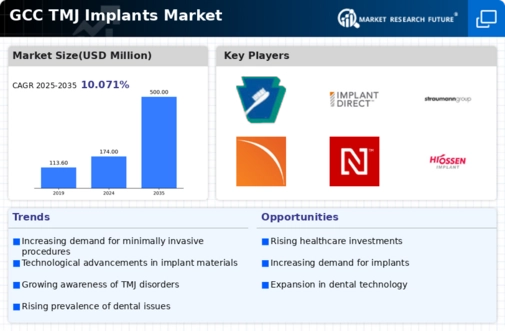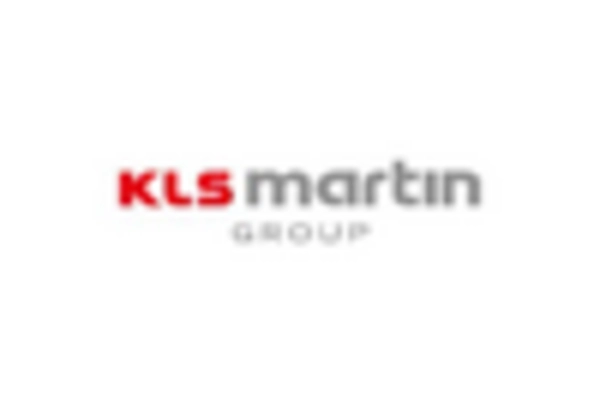Rising Incidence of TMJ Disorders
The increasing prevalence of temporomandibular joint (TMJ) disorders in the GCC region is a primary driver for the tmj implants market. Factors such as stress, poor posture, and dental issues contribute to the rise in these disorders. Recent studies indicate that approximately 10-15% of the population experiences TMJ-related symptoms, leading to a growing demand for effective treatment options. As awareness of these disorders increases, patients are more likely to seek surgical interventions, including implants. This trend is expected to propel the tmj implants market, as healthcare providers aim to address the needs of this expanding patient demographic. Furthermore, the rising incidence of conditions such as arthritis and jaw injuries further fuels the demand for innovative implant solutions, thereby enhancing market growth.
Advancements in Implant Technology
Technological innovations in implant design and materials are significantly influencing the tmj implants market. The introduction of biocompatible materials and 3D printing technology has revolutionized the manufacturing process, allowing for customized implants that better fit individual patient anatomies. These advancements not only improve surgical outcomes but also reduce recovery times, making them more appealing to both patients and healthcare providers. In the GCC, the market for advanced TMJ implants is projected to grow at a CAGR of around 8% over the next five years, driven by these technological enhancements. As more practitioners adopt these cutting-edge solutions, the tmj implants market is likely to expand, catering to a broader range of patients seeking effective treatment options.
Enhanced Patient Education and Support Programs
The establishment of comprehensive patient education and support programs in the GCC is contributing to the growth of the TMJ implants market. These initiatives aim to inform patients about TMJ disorders, treatment options, and the benefits of surgical interventions. As patients become more knowledgeable, they are more likely to pursue treatment, including the use of implants. Healthcare providers are increasingly recognizing the importance of patient engagement in the decision-making process, leading to improved outcomes and satisfaction. This focus on education is likely to stimulate demand for tmj implants, as informed patients actively seek out effective solutions for their TMJ-related issues.
Growing Investment in Healthcare Infrastructure
The GCC region is witnessing substantial investments in healthcare infrastructure, which is positively impacting the TMJ implants market. Governments are prioritizing healthcare development, leading to the establishment of advanced medical facilities equipped with the latest technologies. This investment not only enhances the quality of care but also increases the availability of specialized treatments, including TMJ surgeries. As a result, more patients are gaining access to surgical options, thereby driving demand for tmj implants. The market is expected to benefit from this trend, as improved healthcare facilities attract skilled professionals and foster innovation in treatment methodologies. Consequently, the tmj implants market is likely to experience robust growth in the coming years.
Increasing Demand for Minimally Invasive Procedures
There is a notable shift towards minimally invasive surgical techniques in the GCC, which is influencing the tmj implants market. Patients are increasingly favoring procedures that offer reduced recovery times and lower risks of complications. As a result, healthcare providers are adapting their practices to incorporate these techniques, leading to a rise in the use of TMJ implants that can be inserted with minimal invasiveness. This trend is supported by advancements in surgical tools and techniques, which enhance precision and patient outcomes. The growing preference for minimally invasive options is expected to drive the tmj implants market, as more patients seek effective yet less invasive treatment alternatives.

















Leave a Comment